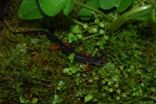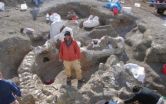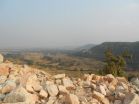(Press-News.org) Salamanders spend the vast majority of their lives below ground and surface only for short periods of time and usually only on wet nights. When they do emerge, salamanders can be spotted not only on forest floors but also up in trees and on other vegetation, often climbing as high as 8 feet. Given their infrequent appearances aboveground, it has never been clear to biologists why salamanders take time to climb vegetation. Researchers at the University of Missouri recently conducted a study testing a long-standing hypothesis that salamanders might climb vegetation for food.
"Previous research suggested that plant climbing might be a way for salamanders to access additional prey items, like aphids and leaf hoppers, that are not available on the ground," said Grant Connette, a biologist who helped carry out the study while a graduate student in the Division of Biological Sciences at MU.
Connette and his colleagues tested the hypothesis by collecting red-legged salamanders (Plethodon sharmani) and examining their stomach contents. The researchers captured an equal number of salamanders on the ground and up on trees or shrubs and then brought them back to the lab, where they anesthetized them and flushed the stomachs of their contents. The salamanders – minus their last meals – were then safely returned to their exact capture location.
The stomach contents were preserved in alcohol and then subsequently dissected apart. Students, assisted by MU Curators' Professor James Carrel and Research Entomologist Mark Deyrup with the Archbold Biological Station in Florida, identified each prey item to the lowest taxonomic level and calculated its mass. At the end, they had a laundry list of things found in the guts of these salamanders.
"The dominant groups were mites, millipedes, beetles, and an assortment of ants," said Carrel. "What was surprising was that the [salamanders] collected on trees did not have anything one would associate with a plant-feeding insect, like aphids."
The diet of the salamanders captured on the ground was the same as the diet of salamanders captured sitting high up on vegetation.
"We found no evidence that climbing allows these salamanders to more fully exploit available food resources, which instead suggests that other mechanisms, such as competition or predator avoidance, might be important influences on salamander populations," said Connette.
The study was prompted by the research of Curators' Professor Ray Semlitsch, who has been studying salamander populations in the Appalachian Mountains since 2005. The mountain range's moist forests make it a global hot spot for a variety of salamander species.
Connette said that by testing a possible explanation for climbing behavior, the research also provides important background information about how salamanders can exist in high densities in North American forests.
INFORMATION:
The study, "Relationship between diet and microhabitat use of red-legged salamanders (Plethodon shermani) in southwestern North Carolina," appeared in the most recent issue of the journal Copeia.
Scientists prove ground and tree salamanders have same diets
Microhabitat use may suggest predator avoidance
2014-09-04
ELSE PRESS RELEASES FROM THIS DATE:
Public trust has dwindled with rise in income inequality
2014-09-04
Trust in others and confidence in societal institutions are at their lowest point in over three decades, analyses of national survey data reveal. The findings are forthcoming in Psychological Science, a journal of the Association for Psychological Science.
"Compared to Americans in the 1970s-2000s, Americans in the last few years are less likely to say they can trust others, and are less likely to believe that institutions such as government, the press, religious organizations, schools, and large corporations are 'doing a good job,'" explains psychological scientist and ...
Researchers turn to plants to help treat hemophilia
2014-09-04
GAINESVILLE, Fla. — Accidents as minor as a slip of the knife while chopping onions can turn dangerous for patients with hemophilia, who lack the necessary proteins in their blood to stem the flow from a wound.
People with severe hemophilia typically receive regular injections of these proteins, called clotting factors, as a treatment for the disease. But up to 30 percent of people with the most common form, hemophilia A, develop antibodies that attack these lifesaving proteins, making it difficult to prevent or treat excessive bleeding.
Now, researchers from University ...
T. rex times 7: New dinosaur species is discovered in Argentina
2014-09-04
Scientists have discovered and described a new supermassive dinosaur species with the most complete skeleton ever found of its type. At 85 feet long and weighing about 65 tons in life, Dreadnoughtus schrani is the largest land animal for which a body mass can be accurately calculated.
Its skeleton is exceptionally complete, with over 70 percent of the bones, excluding the head, represented. Because all previously discovered super-massive dinosaurs are known only from relatively fragmentary remains, Dreadnoughtus offers an unprecedented window into the anatomy and biomechanics ...
INFORMS study: Customer experience matters more when economy is doing better, not worse
2014-09-04
Customer experience matters more when the economy is doing well than when it is doing poorly, according to a new study in the Articles in Advance section of Marketing Science, a journal of the Institute for Operations Research and the Management Sciences (INFORMS).
The study, entitled "Assessing the Influence of Economic and Customer Experience Factors on Service Purchase Behaviors" is by V Kumar, the Regents' Professor, Nita Umashankar, an assistant professor, and PhD candidates Hannah Kim and Yashoda Bhagwat, all at Robinson College of Business at Georgia State University. ...
The Lancet: International health systems fund could have averted Ebola outbreak
2014-09-04
The Ebola crisis in west Africa could have been averted if governments and health agencies had acted on the recommendations of a 2011 World Health Organisation (WHO) Commission on global health emergencies, according to a new Comment, published in The Lancet.
The Comment, written by Professor Lawrence Gostin, Faculty Director of the O'Neill Institute for National & Global Health Law at Georgetown University, USA, calls for renewed international commitment to a health systems contingency fund to prevent another infectious disease crisis, together with long-term funding ...
2014 Breast Cancer Symposium highlights research advances in prevention, screening, therapy
2014-09-04
ALEXANDRIA, Va. – Five studies from the 2014 Breast Cancer Symposium were highlighted today in an embargoed presscast for reporters. Presentations focused on new studies exploring preventive mastectomy, compliance with recommended screening mammography, and risk of recurrence after pre-surgery therapy for breast cancer. The Symposium will take place September 4-6, 2014, at the San Francisco Marriott Marquis in San Francisco, CA.
Five major studies were highlighted in today's presscast:
Angelina Jolie's Story May Have Helped Double BRCA Testing Rates at a Canadian Cancer ...
Messenger molecules identified as part of arthritis puzzle
2014-09-04
The way in which some cells alter their behaviour at the onset of osteoarthritis has been identified for the first time by researchers at the University of Liverpool.
The study was funded by medical research charity Arthritis Research UK.
The trigger for arthritis is still to be fully defined, but it is known that injuries, obesity or old age can all increase the risk for arthritis, and lead to cells in the affected joint altering their behaviour.
The research team from the University's Institute of Ageing and Chronic Disease has now found that changes in the rate ...
Researcher advances a new model for a cosmological enigma -- dark matter
2014-09-04
LAWRENCE — Astrophysicists believe that about 80 percent of the substance of our universe is made up of mysterious "dark matter" that can't be perceived by human senses or scientific instruments.
"Dark matter has not yet been detected in a lab. We infer about it from astronomical observations," said Mikhail Medvedev, professor of physics and astronomy at the University of Kansas, who has just published breakthrough research on dark matter that merited the cover of Physical Review Letters, the world's most prestigious journal of physics research.
Medvedev proposes a ...
Atomically thin material opens door for integrated nanophotonic circuits
2014-09-04
A new combination of materials can efficiently guide electricity and light along the same tiny wire, a finding that could be a step towards building computer chips capable of transporting digital information at the speed of light.
Reporting today in The Optical Society's (OSA) high-impact journal Optica, optical and material scientists at the University of Rochester and Swiss Federal Institute of Technology in Zurich describe a basic model circuit consisting of a silver nanowire and a single-layer flake of molybendum disulfide (MoS2).
Using a laser to excite electromagnetic ...
Trinity geologists re-write Earth's evolutionary history books
2014-09-04
Geologists from Trinity College Dublin have rewritten the evolutionary history books by finding that oxygen-producing life forms were present on Earth some 3 billion years ago – a full 60 million years earlier than previously thought. These life forms were responsible for adding oxygen (O2) to our atmosphere, which laid the foundations for more complex life to evolve and proliferate.
Working with Professors Joydip Mukhopadhyay and Gautam Ghosh and other colleagues from the Presidency University in Kolkata, India, the geologists found evidence for chemical weathering of ...
LAST 30 PRESS RELEASES:
Be careful trusting TikTok for gout advice
A study by the University of Seville links the vanishing of the specific heats at absolute zero with the principle of entropy increase
Anxiety and insomnia may lower natural killer cell count, potentially repressing immune function
How parasitic, asexual plants evolve and live
Research spotlight: A subset of patients with depression could benefit from anti-inflammatory treatment
New fully digital design paves the way for scalable probabilistic computing
Membrane electrode assembly design for high-efficiency anion exchange membrane water electrolysis
U.S. debt ceiling disputes show measurable impact on global crude oil markets
Climate extremes triggered rare coral disease and mass mortality on the Great Barrier Reef
Direct observation reveals “two-in-one” roles of plasma turbulence
Humans rank between meerkats and beavers in monogamy ‘league table’
US fossil reveals early mass-burial event and ancient microbial attack
Sedative choice could improve outcomes for breathing tube patients
New superconducting thin film for quantum computer chips
Simulations reveal protein "dynamin" constricts cell membranes by loosening its grip
Nearly 1 in 5 UK emergency department patients cared for in corridors/waiting rooms
Heavy energy drink intake may pose serious stroke risk, doctors warn
Violence against women and children among top health threats: New global study reveals disease burden far larger than previously estimated
Predicting who is at risk of developing type 1 diabetes, as new drugs now available
New gene-mapping method unlocks hidden drivers of cancer
Ocean current and seabed shape influence warm water circulation under ice shelves
Call to increase funding for ‘invisible’ Deaf victim-survivors of domestic abuse
University of Maryland School of Medicine names distinguished scientist and academic leader Gerald M. Wilson, PhD, as Chair of the Department of Biochemistry and Molecular Biology
Receptors in mammary glands make livestock and humans inviting hosts for avian flu
Icy hot plasmas
Treating adults with autism: Maryland Clinical Center offers national blueprint for care after pediatric transition
University of Phoenix College of Doctoral Studies releases white paper on reclaiming control to build workforce resilience
NCCN Summit seeks to improve care for veterans and first responders with cancer from line-of-duty exposure
ERC Consolidator Grant for soft robotics researcher
Dual-action arts and wellbeing program transforms dementia care
[Press-News.org] Scientists prove ground and tree salamanders have same dietsMicrohabitat use may suggest predator avoidance




